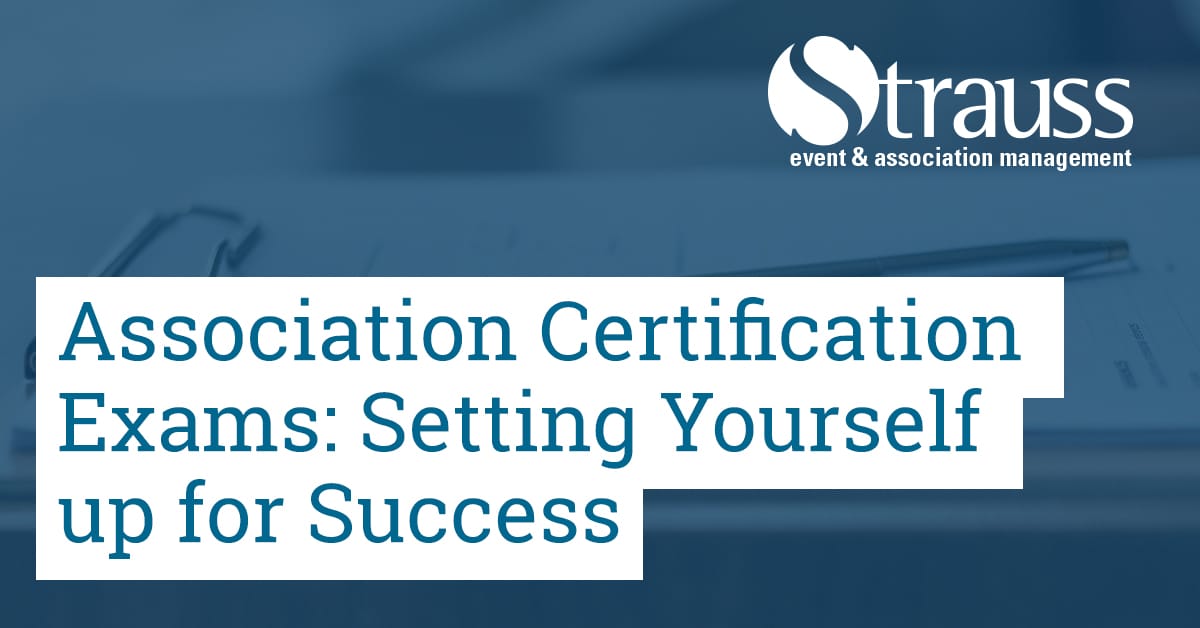Whenever there is a certification connected to an association’s membership, it is likely that members have needed to challenge their College’s exam to use said title in their professional practice. In association management companies (AMCs), the association coordinator is tasked with organizing and planning the certification exams. This task may seem like a colossal undertaking for one person, especially if there are exam sites across the country, but with the help of a well-documented execution plan, it is bound to be a success.
Creating the Execution Plan
The key to running a smooth certification exam is creating a clear and documented plan of execution. A complete exam execution plan should contain the following details:
- Deadlines
- Timelines
- Cues for action
- Tasks and instructions for completing them
- Contact information
Suggested Deadlines and Timelines
Creating and sticking to strict deadlines and timelines is crucial for organizing a well-orchestrated certification exam. By incorporating a mapped-out schedule into the execution plan, all the planning information needed for the exam will be in one document. With experience, you’ll get to know the timelines that work for your association or college; below are some guidelines for planning.
| Task | Deadline/ Timeline | Notes |
| Book exam session venues | At least one year in advance | Note deadlines for catering and payments |
| Update and post exam application | As soon as previous sitting has passed or at least 6 months before the exam | Application submission deadline should be at least 1 month before the exam |
| Send out “Save the Date” for potential volunteer proctors | 3 months before the exam | Allowing association members to plan |
| Make any necessary updates to the exam | Must be complete at least 1 month before the exam | Give committee members time required to review the exam |
| Send exam candidate confirmations | After application deadline | Provide exam location, time and exam preparation details |
| Confirm exam proctors and locations | 1 month before the exam | Allows members time to solidify their schedules, also allows time to find replacements if necessary |
| Send exam to printing company | 3 weeks before the exam | Depending on speed of service and volume of printing |
| Send out proctor information packages and instructions | 2 weeks before the exam | Gives volunteers time to understand their role and to ask any questions |
| Mail out exam packages to respective exam sites | Schedule packages to arrive at least a week before the exam | Allows proctors to review contents and prepare for the exam sitting |
Cues for Action and Task Instructions
Cues for action will naturally be inserted into a well-thought-out execution plan. When creating a plan for an exam, always keep in mind the importance of properly documenting tasks; this ensures that the processes remain consistent from sitting to sitting and that the next step is always clear. Cues for action and task instructions will flow from one to another throughout your plan once you’ve nailed down a solid routine. Listed below are some examples of cues for action, followed by their task instructions.
| Cue for Action | Task Instruction |
| Exam application is received by the association coordinator | 1) Ensure that the exam application contains all required documentation and that the candidate meets the exam requirements 2) Enter candidate’s information in exam sitting spreadsheet 3) Enter candidate’s information in membership database platform |
| Exam application deadline passes | 1) Confirm all required proctors and exam locations 2) Send candidates their exam confirmations with date, time and location |
| Completed exams are returned to the association coordinator | 1) Follow exam marking procedures 2) Send candidates exam results and new member packages OR fail reports, depending on results |
Contact Information
Organizing a certification exam is not a one-person show. The association coordinator is responsible for planning the exam from the association management office, but they’ll need to depend on outside help from volunteers and members, liaisons, and other organizations during certain steps of the process. It will be handy to include these contacts in your execution plan:
- Head/lead proctors for each exam location
- Exam supply delivery (if required)
- Exam printing company
- Exam marking liaison (if marking is done but outside organization)
- Venue booking agent
- Exam committee
Implementing the Execution Plan
Now that an all-inclusive certification exam execution plan has been created, the exam should go off without a hitch! By creating this plan, you’ll be ensuring continuity and consistency within the association when it comes to processes, tasks and instructions for all aspects of their certification exam. When the steps are clear and easy to follow, the association coordinator will be able to organize their certification exam with confidence and clarity. This will, in turn, give association members peace of mind that their organization is being diligently managed and that they can trust that qualified professionals are being introduced into their profession after passing a well-run certification exam.
For further insight on the role of an association coordinator, check out the following blog articles written by my amazing colleagues:

